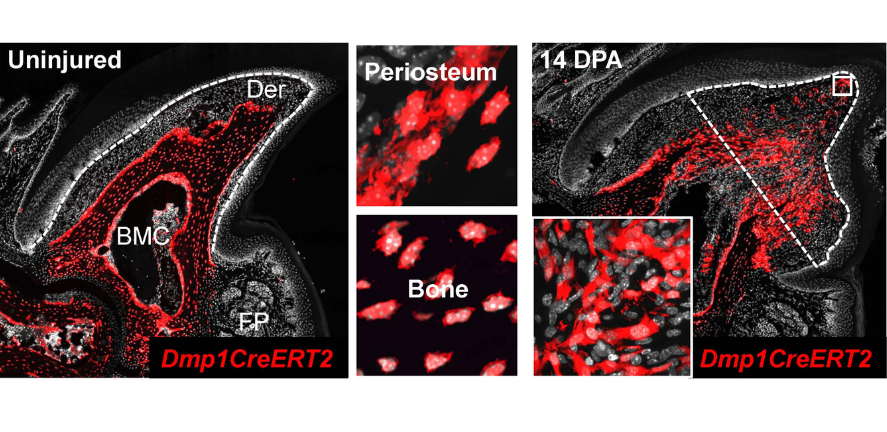Dr Mekayla Storer
Stem cells and limb regeneration
Email: ms2786@cam.ac.uk
Laboratory: Cambridge Stem cell Institute, Jeffrey Cheah Biomedical Centre
Departmental Affiliation: Physiology, Development and Neuroscience (PDN)
Biography
Mekayla Storer is a developmental biologist focusing on how stem cells regenerate mammalian digits. She obtained her PhD at the Centre for Genomic Regulation in Barcelona, Spain under the guidance of Dr. Bill Keyes where she discovered that senescence evolved as a way to build mammalian limbs and is required for normal development. In 2015, she joined the laboratory of Drs. Freda Miller and David Kaplan at the Hospital for Sick Children in Canada to pursue her post-doctoral training. Here, she spent five years studying stem cell behaviour during neural development and digit tip regeneration using genetic lineage tracing techniques and single cell transcriptomic approaches.
Mekayla is currently a Group Leader at the Wellcome-MRC Cambridge Stem Cell Institute and affiliate at the University of Cambridge.
Bone-associated cells (osteocytes and periosteal cells) marked by Dmp1 contribute to the regenerating blastema (outlined by the white dashed line in the image on the right).
Research
The digit tip is the only part of the limb that can regenerate in mammals. The key step in this process is the formation of the blastema, a transiently proliferating cell mass that generates the different cell types of the digit to replicate the original structure. Therefore, understanding how the blastema forms and functions during digit tip regeneration will provide clues as to how we can stimulate regeneration of limbs and other tissues.
The Storer Group seeks to understand the cellular and molecular mechanisms necessary for blastema formation, and how these cells are co-ordinated temporally and spatially to regenerate the injured digit tip. Toward that end, they utilise in vitro blastema cultures, single-cell transcriptomic approaches and in vivo genetic lineage tracing studies.
Plain English
The life of a salamander is an enviable thing. If this animal loses a limb, it can just grow another one. Imagine if we could do that. It’s not all bad news however. Mice and humans have retained a sliver of regenerative ability. If you damage the end of your finger, as long as there is a bit of nail left over and the wound is not stitched up, it will grow back. In my lab, we are trying to understand why we can regenerate a fingertip but not an entire arm. If we can understand how the tip of the finger regenerates, we can use this knowledge to develop therapies to regenerate other parts of the body.
Key Publications
- Zhang, B., He, P., Lawrence, J.E.G., Wang, S., Tuck, E., Williams, B.A., Roberts, K., Kleshchevnikov, V., Mamanova, L., Bolt, L., Polanski, K., Li, T., Elmentaite, R., Fasouli, E.S., Prete, M., He, X., Yayon, N., Fu, Y., Yang, H., Liang, C., Zhang, H., Blain, R., Chedotal, A., FitzPatrick, D.R., Firth, H., Dean, A., Bayraktar, O.A., Marioni, J.C., Barker, R.A., Storer, M.A., Wold, B.J., Zhangg, H., & Teichmann, S.A. A human embryonic limb cell atlas resolved in space and time. Nature (2023). https://doi.org/10.1038/s41586-023-06806-x
- Mahmud N*, Eisner C*, Purushothaman S*, Storer MA, Kaplan DR, Miller FD. (2022) Nail-associated mesenchymal cells contribute to and are essential for dorsal digit tip regeneration. Cell Reports. (12) 111853. https://doi.org/10.1016/j. celrep.2022.111853
- Storer, M.A.*, Mahmud, N.*, Karamboulas, K., Borrett, M.J., Yuzwa, S.A., Gont, A., Androschuk, A., Sefton, M.V., Kaplan, D.R. and Miller, F.D.(2020) Acquisition of a unique mesenchymal precursor-like blastema state underlies successful adult mammalian digit tip regeneration. Dev. Cell. 52 (4) 509-524. PMID: 31902657 *Equal Contribution.
- Storer, M.A., Gallagher, D., Fatt, M.P., Simonetta, J.V., Kaplan, D.R. and Miller, F.D. (2018) Interleukin-6 regulates adult neural stem cell numbers during normal and abnormal post-natal development. Stem Cell Reports. 10 (5) 1464 – 1480. PMCID: PMC5995693
- Ritschka, B., Storer, M.A., Mas, A., Heinzmann, F., Ortells, M.C., Morton, J.P., Sansom, O.J., Zender, L. and Keyes, W.M. (2017) The senescence-associated secretory phenotype induces cellular plasticity and tissue regeneration. Genes Dev. 31 (2) 172 – 183. PMCID: PMC5322731
- Johnston, A.P., Yuzwa, S.A., Carr, M.J., Mahmud, N., Storer, M.A., Krause, M.P., Jones, K., Paul, S., Kaplan, D.R. and Miller, F.D. (2016) Dedifferentiated Schwann cell precursors secreting paracrine factors are required for regeneration of the mammalian digit tip. Cell Stem Cell. 19 (4) 433 – 448. PMID: 27376984
- Storer, M.A., Mas, A., Robert-Moreno, A., Pecoraro, M., Ortells, M.C., Giacomo, V., Yosef, R., Pilpel, N., Krizhanovsky, V., Sharpe, J. and Keyes, W.M. (2013) Senescence is a developmental mechanism that contributes to embryonic growth and patterning. Cell. 155 (5) 1119 – 1130. PMID: 24238961



